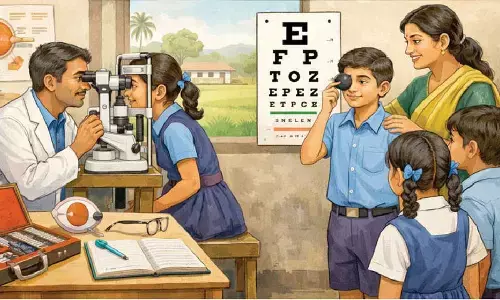Bell Palsy: Diagnosis and Management

Bell Palsy: Diagnosis and Management
Bell's Palsy is sudden difficulty in closing one's eye on either side along with deviation of mouth to opposite side, liquids trickling down along the angle of mouth, food material accumulating on the affected side inability to blow the cheek along with flattening of forehead furrows on the affected side.
Bell's Palsy is sudden difficulty in closing one's eye on either side along with deviation of mouth to opposite side, liquids trickling down along the angle of mouth, food material accumulating on the affected side inability to blow the cheek along with flattening of forehead furrows on the affected side.
Bell's palsy is due to affection of 7th cranial nerve of brain. Normally in every human being there are 12 pairs of cranial nerves, each is designed with a special purpose. In Bell's palsy all the muscles controlled by 7th nerve 'FACIAL NERVE' are paralyzed. The problem is very troublesome inconvenient and scary.
Residual deficits may remain for a long time, if timely treatment is not carried out. Most of the times the cause of Bell's palsy is not well established.
The known causes are
l Exposure to sudden cold
l Pain in the ear due to ear infection
l Injury to the outer aspect of ear, mastoid bone with bleeding from ear.
l Some space occupying lesions inside the brain in a tight area called CP ANGLE – like brain tumors, collection of pus, abnormality of blood vessels and local infections.
l Lastly secondary to diabetes.
Investigations include
l Fasting blood sugar
l CT Scan, Brain Plain + contrast.
l MRI Brain occasionally
Treatment will depend upon the cause and should be started immediately. In 80-90% of times medical treatment along with intensive physiotherapy. Medical treatment mainly consists of steroids – initially injectable followed by tablets course for one week to 10 days. During steroid usage, blood sugars to be checked up every 3 days, as steroids may precipitate diabetes, even in a non-diabetic patient.
Physiotherapy includes exercises to stimulate all the affected facial muscles like
l Lifting of eyebrows repeatedly
l Trying to close and open the eyes.
l Blowing plus filling up of air in cheeks
l Massaging of affected side of face
l Filling up rubber balloons many times
l Chewing of soft things like chewing gum on the affected side.
l Lastly stimulation of face with specified degree of Galvanic stimulation method.
Precautions include protecting the eye with 'EYE Drops' using Cooling glasses, avoiding exposure to strong winds, and avoid two-wheeler driving.
Generally, recovery is very good in most of patients. If the Bell's Palsy is due to head injury it depends on whether Bell's Palsy developed immediately or some time later. Recovery is better in those patients where Bell's palsy develops few days after head injury. Patients with problems inside brain, surgical treatment is the rule.
Summary
l Bell's Palsy is common occurrence
l Definite cause unknown mostly
l Good results are ensured if appropriate treatment is initiated in time like one stich in time saves nine.
l In the persisting residual Bell's palsy, nerve grafting's may be considered.
(The doctor is an MBBS, MCh (Neurosurgery), AIIMS (New Delhi)and senior consultant Neurosurgeon at SLG Hospitals, Ph: +91 9848011185 SLG Circle,No.306, Nizampet Road, Bachupally, Hyderabad Ph: +914023785678/ 7799235678 Email: [email protected])

















